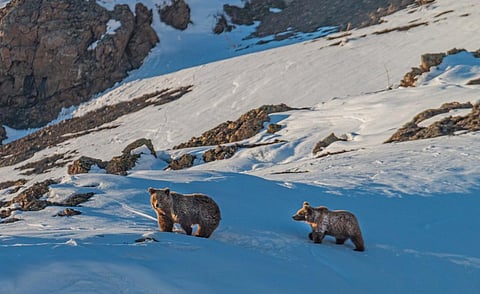

A Himalayan brown bear (Ursus arctos isabellinus) was captured by the Jammu and Kashmir Wildlife Department on May 13, 2023, at Rajwara in the North Kashmir district of Handwara, days after it was found wrecking graveyards, reportedly in search of human cadavers to eat.
The animal also roamed residential areas, posing danger to people’s lives and their livestock.
More such incidents have been reported from villages such as Behnipora, Budshungi, and Shatigam, making residents fear that more than one bear might be on the loose, looking for food.
“We were frightened to see corpses being dug out from graves,” said Abdur Raheem Bhat, a resident of Rajpora village. “But then we came to know that a bear was doing it.”
The villagers have been taking turns to guard their cemetries after dusk. But so far, there seems to be no end to their ordeal.
One explanation for the bears’ weird behaviour is the insufficient food in their habitats. Last year, a study carried out by Wildlife SOS, a New Delhi-based wildlife conservation organisation, revealed that 75 per cent of food items in Himalayan brown bears’ diet in Kashmir was scavenged from garbage including plastic carry bags, milk powder, chocolate wrappers and biryani (rice and meat preparation).
“The Himalayan brown bear population in Kashmir has been a mystery for wildlife conservationists and researchers due to the species’ restricted distribution in the alpine meadows of the Himalayas. Scant information exists about the brown bear and almost no research,” the study said.
Threatened by habitat destruction due to various anthropogenic pressures such as habitat encroachment, tourism, and grazing pressure, the Himalayan brown bear population has been steadily declining in the past century with only an estimated 500-750 bears left in India.
The survey was conducted in areas which included Thajwas (Baltal) Wildlife Sanctuary, Sonamarg, Laxpathri and Sarbal villages since they are critical bear habitats and prime tourist destinations.
Sonamarg in particular was chosen due to its role as a bear habitat extending up to the Zoji La Pass that connects Srinagar with Leh, the study stated.
The normal food of brown bears is insects, small crustaceans, alpine bulbs, roots of plants, shoots of young grasses, domestic goats, sheep and voles. They are nocturnal, and their sense of smell is acutely developed and believed to be their principal means of finding food.
The Himalayan brown bear is the largest mammal found in Kashmir, with adult individuals weighing 250 kilograms or more. They inhabit altitudes ranging from 2,000 to 2,500 metres, predominantly above the tree line.
Brown bears are distributed worldwide and include the famous Grizzly of North America. The northern mountains of India and Pakistan are home to the species’ Himalayan variant, which is critically endangered.
Himalayan brown bears are found in various parts of the subcontinent, including Pakistan, Pakistan-occupied Kashmir, Uttarakhand, Himachal Pradesh and Jammu and Kashmir.
“Due to the remote terrains they occupied, the Himalayan brown bear was a rare sight for the last two decades,” the report stated. “Recently, however, brown bears have increasingly come into the purview of humans as they descend onto lower altitudes in search of food.”
Wildlife conservationists in Kashmir have noted increasing sightings of the brown bear in the last two to three years in the hills of Sonamarg, Drass, Kupwara, Pahalgam, the Pir Panjal range and Gurez in the Bandipora district.
“This is a new thing. Sightings of brown bears have become frequent over the past few years,” said Wildlife Warden, Shopian division, Intisar Suhail. “And the forays of the animals into residential areas has to do more with humans than the animals as we are increasingly encroaching onto their habitat.”
Suhail blamed “the improper disposal of kitchen waste” both by people and hoteliers close to the habitat of brown bear. “This makes food easily available to the animals and they come for it frequently,” he said. “And in the process, they come into contact with humans.”
The official warned that the easy food had, in turn, altered the behaviour of the brown bear. “They are delaying their hibernation now,” he said. “Another thing is that they have tended to become complacent, preferring not to hunt for food.”
The brown bear goes into hibernation around October and emerges around April and May. It has been observed to prefer open valleys and pastures and during summer, it moves as high as 5,500 metres and returns to the valleys in the autumn.
In India, brown bears are present in 23 protected areas (PA) in the Union Territory of Jammu and Kashmir, and the states of Himachal Pradesh and Uttarakhand. Their global number is estimated to be less than 1,000 and possibly half that in India.
The Himalayan brown bears are listed as “critically endangered” in the International Union for the Conservation of Nature Red List. And the future doesn’t offer much hope.
According to a study carried out in the western Himalayas by scientists of Zoological Survey of India in 2020, there will be a decline of about 73 per cent of the bear’s habitat by 2050.
The scientists predicted a significant reduction in suitable habitat and biological corridors of the species in a climate change scenario, prompting them to recommend “preemptive spatial planning of PAs in the Himalayan region for the long-term viability of the species”.
The increasing incidents of conflict between Himalayan bown bear with people in Kashmir only further bears out this study.